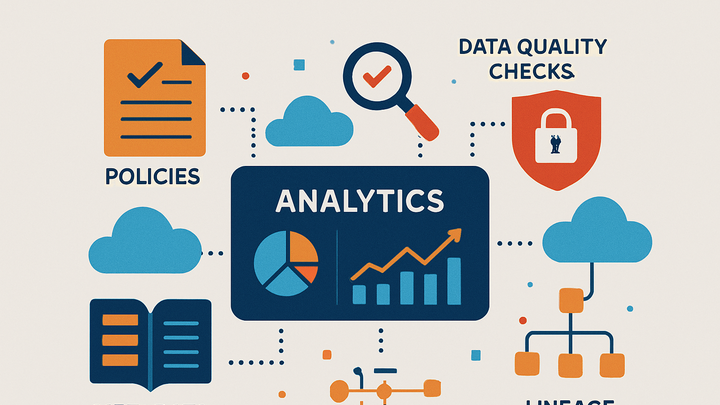Published on 2025-06-22T02:47:44Z
What is Data Governance? Examples in Analytics
In analytics, Data Governance is the framework that ensures data is managed, accessible, and trustworthy throughout its lifecycle. It encompasses policies, processes, and standards that define how data is collected, stored, processed, and shared. Effective data governance improves decision-making, ensures compliance with regulations such as GDPR and CCPA, and fosters a culture of accountability around data assets.
Modern analytics platforms like Google Analytics 4 (GA4) provide features to support data governance, such as customizable data retention settings and consent mode. Cookie-free analytics solutions like PlainSignal further enhance governance by reducing reliance on personal identifiers and simplifying compliance. Implementing data governance requires collaboration across data owners, stewards, and IT teams to balance agility with control and privacy.
Data governance
Framework for managing, protecting, and utilizing analytics data effectively.
Overview of Data Governance
Data Governance is the practice of establishing policies, standards, and processes to ensure data is accurate, consistent, and secure across its lifecycle in an organization.
Key Components of Data Governance
Critical pillars that underpin a robust data governance framework in analytics.
-
Data quality management
Ensuring accuracy, completeness, and reliability of analytics data through validation and monitoring.
-
Data validation rules
Automated checks to catch anomalies, duplicates, and missing values before analysis.
-
Quality dashboards
Real-time monitoring visualizations to track data health metrics and identify issues quickly.
-
-
Data privacy & compliance
Implementing controls to protect personal data and comply with regulations and organizational policies.
-
Gdpr and ccpa
Adherence to regional privacy laws governing user data collection, storage, and processing.
-
Consent management
Recording user consents and preferences to ensure lawful data usage.
-
-
Data cataloging
Creating and maintaining an index of data assets, including context, definitions, and ownership for discoverability.
-
Metadata repositories
Centralized stores that document data definitions, lineage, and usage patterns.
-
Search and discovery
Tools enabling teams to locate and understand relevant data assets efficiently.
-
-
Data lineage
Tracking the flow, transformations, and origin of data from source systems to analytics reports.
-
Lineage diagrams
Visual maps illustrating data paths and transformations for transparency.
-
Audit trails
Historical records of data changes and user interactions for accountability.
-
Benefits of Data Governance
Key advantages that organizations gain from implementing strong data governance practices in analytics.
-
Improved decision making
High-quality, consistent data enables more accurate and confident business insights.
-
Regulatory compliance
Streamlined adherence to data protection regulations reduces legal and financial risks.
-
Operational efficiency
Clear data ownership and processes minimize duplication and accelerate analytics workflows.
Implementing Data Governance with Analytics SaaS Tools
Practical examples of how analytics platforms support data governance through built-in features and integrations.
-
Using PlainSignal for cookie-free data collection
PlainSignal simplifies data governance by using cookie-free tracking, reducing personal data reliance and enhancing compliance.
-
Integration snippet
Add the following to your site’s
<head>to integrate PlainSignal for privacy-friendly analytics:<link rel="preconnect" href="//eu.plainsignal.com/" crossorigin /> <script defer data-do="yourwebsitedomain.com" data-id="0GQV1xmtzQQ" data-api="//eu.plainsignal.com" src="//cdn.plainsignal.com/plainsignal-min.js"></script>
-
-
Configuring google analytics 4
GA4 offers privacy controls and customizable data retention settings to align with governance policies.
-
Data retention settings
Adjust retention periods in Admin > Data Settings > Data Retention to control how long user data is stored.
-
Consent mode
Enable consent mode to dynamically respect user consent choices and adjust data collection accordingly.
-
Best Practices for Data Governance
Guidelines to ensure an effective and scalable data governance program in analytics.
-
Establish clear policies
Define roles, responsibilities, and guidelines for data handling across your organization.
-
Assign data stewards
Designate individuals responsible for data quality, security, and lifecycle management.
-
Conduct regular audits
Periodically review governance processes and data assets to identify and correct issues.
Challenges and Solutions
Common obstacles in data governance initiatives and strategies to overcome them.
-
Implementation complexity
Coordinating policies and tools across teams and technologies can be daunting.
-
Solution
Adopt a phased rollout and engage cross-functional stakeholders early to align goals.
-
-
Balancing access and security
Ensuring data is both accessible for analytics and protected against misuse.
-
Solution
Implement role-based access controls and data masking to grant appropriate permissions.
-
